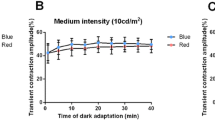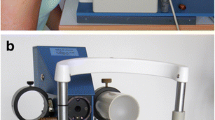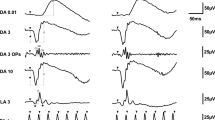Abstract
Light-induced extracellular potassium changes were measured in the isolated rabbit retina superfused by a plasma saline mixture and compared with the electroretinogram. When the transmission to second-order neurons was blocked by aspartate and glutamate or by Mg2+, the electroretinogram consisted of the receptor potential and the cornea-negative slow PIII. Since the onset of PIII could then be seen to precede the decrease in extracellular potassium concentration ([K+]0) around photoreceptors, the [K+]0 decrease could not be the cause of the onset of slow PIII. A possible source for the initial phase of slow PIII could be the electrogenic Na+/bicarbonate transporter mechanism of glial cells. Slow PIII depended highly on the extracellular sodium concentration, and it was larger in solutions buffered with bicarbonate than with HEPES, while the [K+]0 decrease around receptors was unchanged.
Similar content being viewed by others
References
Oakley B II, Green DG. Correlation of light—induced changes in extracellular potassium concentration with the c—wave of the electroretinogram. J Neurophysiol 1976; 39: 1117–33.
Tomita T. Electrophysiological studies of retinal cell function. Invest Ophthalmol 1976; 15: 169–87.
Fujimoto M, Tomita T. Reconstruction of the slow PIII from the rod potential. Invest Ophthalmol Vis Sci 1979; 18: 1090–3.
Karwoski CJ, Proenza LM. Sources and sinks of light—evoked [K+]0 in the vertebrate retina. Can J Physiol Pharmacol 1987; 65: 1009–17.
Hanitzsch R. The time course of the light—induced extracellular potassium change around receptors and the vitreal surface compared with the time course of slow PIII—wave in the isolated rabbit retina. Physiol Bohemoslov 1988; 37: 227–33.
Mättig WU, Hanitzsch R. Measurements of the extracellular potassium concentrations in the isolated rabbit retina with different kinds of potassium microelectrodes. J Neurosci Methods 1991; 40 127–32.
Hanitzsch R. A comparison between the slow cornea—negative component of the electroretinogram (ERG) and extracellular K+ changes in the isolated rabbit retina. J Physiol 1990; 425: 50P.
Hanitzsch R, Bornschein H. Spezielle Überlebensbedingungen für isolierte Netzhäute verschiedener Warmblüter. Experientia 1965; 21: 484.
Hanitzsch R. Dependence of the b—wave on the potassium concentration in the isolated superfused rabbit retina. Doc Ophthalmol 1981; 51: 235–40.
Hanitzsch R, Tomita T, Wagner H. A chamber preserving cellular function of the isolated rabbit retina suited for extracellular and intracellular recordings. Ophthalmic Res 1984; 16: 27–30.
Normann RA, Perlman I, Daly SJ. The effects of continuous superfusion of L—aspartate and L—glutamate on horizontal cells of the turtle retina. Vision Res 1986; 26: 259–68.
Miyachi EI, Lukasiewicz PD, McReynolds JS. Excitatory amino acids have different effects on horizontal cells in eye cup and isolated retina. Vision Res 1987; 27: 209–14.
Shimazaki H, Karwoski CJ, Proenza LM. Aspartate—induced dissociation of proximal from distal retinal activity in the mudpuppy. Vision Res 1984; 24: 587–95.
Hanitzsch R, Trifonow J. Intraretinal abgeleitete ERG—Komponenten der isolierten Kaninchennetzhaut. Vision Res 1968; 8: 1445–55.
Kuffler SW, Nicholls JR, Orkand RK. Physiological properties of glial cells in the central nervous system of amphibia. J Neurophysiol 1966; 29: 768–87.
Newman EA. Membrane physiology of retinal glial (Müller) cells. J Neurosci 1985; 5: 2225–39.
Coles JA. Homeostasis of extracellular fluid in retinas of invertebrates and vertebrates. In: Autrum H, Ottoson D, eds. Progress in sensory physiology. New York: Springer Verlag, 1985; 6: 105–38.
Brew H, Attwell D. Electrogenic glutamate uptake is a major current carrier in the membrane of axolotl retinal glial cells. Nature 1987; 327: 707–9.
Deitmar JW, Schlue WR. An inwardly directed electrogenic sodium—bicarbonate co—transport in leech glial cells. J Physiol 1989; 411: 179–94.
Deitmer JE, Szatkowski M. Membrane potential dependence of intracellular pH regulation by identified glial cells, in the leech central nervous system. J Physiol 1990; 421: 617–31.
Newman EA, Astion ML. Localization and stochiometry of electrogenic sodium bicarbonate co-transport in retinal glial cells. Glia 1991; 4: 424–8.
Hanitzsch R. Intraretinal isolation of PIII—subcomponents in the isolated rabbit retina after treatment with sodium aspartate. Vision Res 1973; 13: 2093–102.
Witkovsky P, Dudek FE, Ripps H. Slow PIII of the carp electroretinogram. J Gen Physiol 1975; 65: 119–35.
Valeton JM, van Norren D. Fractional recording and component analysis of primate LERG. Separation of photoreceptor and other retinal potentials. Vision Res 1982; 22: 381–92.
Oakley B II, Flaming DG, Brown KT. Effects of the rod receptor potential upon retinal extracellular potassium concentration. J Gen Physiol 1979; 74: 713–39.
Oakley B II, Wen R. Extracellular pH in the isolated retina of the toad in darkness and during illumination. J Physiol 1989; 419: 353–78.
Bykow KA, Dmitriev AV, Skachkov SN. Relationship between photoinduced change of the extracellular potassium ion concentration and transretinal potential generation by Müller cells of the retina. Biofizika 1981; 26: 104–7. In Russian.
Bornschein H, Hanitzsch R, von Lützow A. Off—Effect und negative ERG—Komponente des enukleierten Bulbus und der Retina des Kaninchen, I: Einfluss der Reizparameter. Vision Res 1966; 6: 251–9.
Author information
Authors and Affiliations
Rights and permissions
About this article
Cite this article
Hanitzsch, R. Comparison between the slow cornea—negative PIII component of the ERG and potassium changes in the isolated rabbit retina. Doc Ophthalmol 84, 267–278 (1993). https://doi.org/10.1007/BF01203659
Accepted:
Issue Date:
DOI: https://doi.org/10.1007/BF01203659




